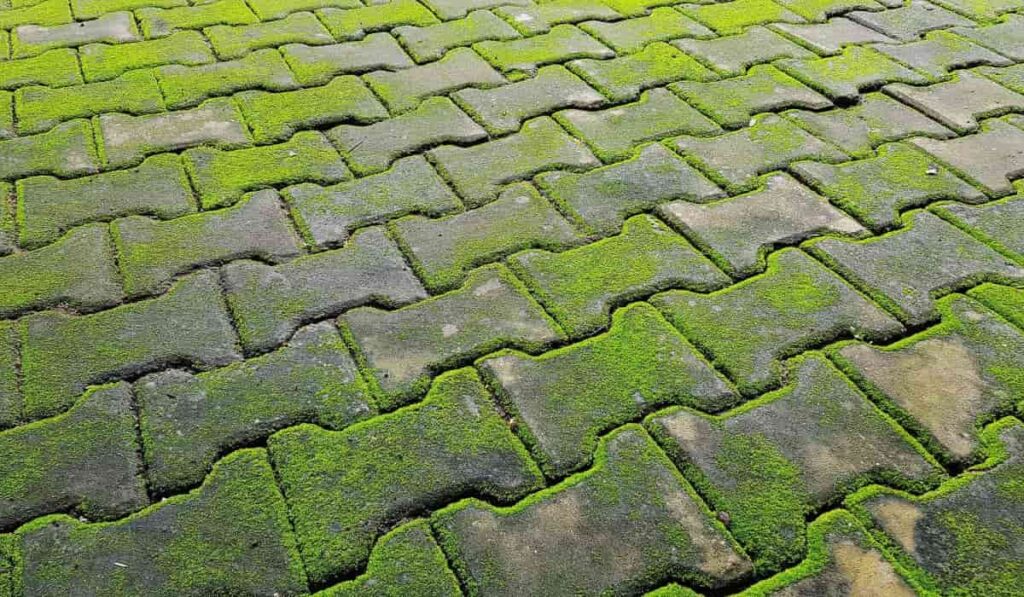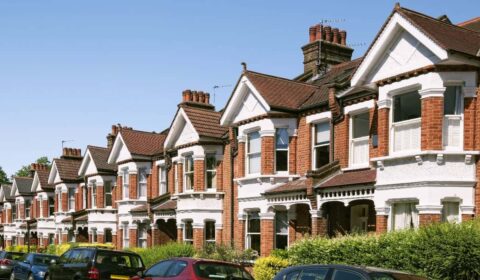How to Get Rid of Green Algae on Concrete?
- Scrub with Soapy Water – Use a stiff brush and warm, soapy water to scrub away algae.
- Use White Vinegar – A natural solution! Spray a vinegar-water mix, let it sit, then scrub and rinse.
- Baking Soda Method – Sprinkle baking soda, let it sit, then scrub and rinse for a chemical-free approach.
- Lemon Juice – Apply fresh lemon juice, leave it for 15–20 minutes, then scrub and rinse.
- Pressure Wash – For large areas, use a pressure washer to remove algae effectively.
- Bleach Solution – Mix one part bleach with four parts water, apply, scrub, and rinse (use with caution).
- Prevent algae regrowth by improving drainage, increasing sunlight exposure, and sealing concrete surfaces naturally with eco-friendly sealants.
Green algae on concrete surfaces can be slippery, especially in damp and shaded areas. If left untreated, it can cause discolouration and make surfaces hazardous. Fortunately, removing green algae from concrete is relatively simple with the right methods. This guide will explore how to effectively eliminate green algae on concrete, using various techniques and preventive measures to keep your surfaces clean and algae-free.
Why Does Green Algae Grow on Concrete?
Green algae thrive in damp, shaded environments with limited sunlight. Concrete surfaces, such as driveways, patios, and pathways, are prone to algae growth when exposed to moisture, humidity, and organic matter. Standing water, poor Drainage, and lack of airflow further encourage algae growth.
Common causes of green algae on concrete include:
- Excess moisture from rain, leaks, or poor Drainage
- Shady areas with minimal sunlight exposure
- Accumulated dirt, leaves, and organic debris
- High humidity levels
Understanding the causes of green algae can help choose the most effective removal and prevention methods.
Must Read: What is the Fastest Way to Remove Algae from Decking?
How to Remove Green Algae from Concrete
Several methods exist to eliminate green algae from concrete surfaces. The following techniques will help restore your concrete to its original state.
Scrubbing with a Stiff Brush and Soapy Water
A simple solution of water and dish soap can be effective for mild algae growth.
What You Need:
- A stiff-bristled brush
- Warm water
- Mild dish soap
- A bucket
Steps:
- Mix warm water with a few drops of dish soap in a bucket.
- Pour the soapy solution onto the affected area.
- Scrub vigorously with a stiff brush to loosen and remove algae.
- Rinse with clean water and allow the area to dry.
Using White Vinegar Solution
Vinegar is a natural and eco-friendly solution for eliminating green algae from concrete.
What You Need:
- White vinegar
- Water
- A spray bottle
- A scrub brush
Steps:
- Mix equal parts of white vinegar and water in a spray bottle.
- Spray the solution generously on the algae-covered area.
- Allow it to sit for 20–30 minutes.
- Scrub the surface with a brush to remove algae.
- Rinse thoroughly with water.
Applying Bleach for Stubborn Algae Growth
Bleach is a powerful disinfectant that effectively kills algae.
What You Need:
- Bleach (household chlorine bleach)
- Water
- A bucket
- A stiff brush
- Protective gloves
Steps:
- Dilute bleach by mixing one part bleach with four parts water.
- Pour or spray the solution onto the algae-covered concrete.
- Let it sit for 10–15 minutes to break down the algae.
- Scrub the surface thoroughly with a stiff brush.
- Rinse the area with plenty of water to remove bleach residue.
Safety Tip: Always wear protective gloves and avoid splashing bleach on your skin or clothing. Ensure proper ventilation when using bleach.
Pressure Washing for Large Areas
A pressure washer is an effective way to remove green algae from large concrete surfaces.
What You Need:
- A pressure washer
- Water
- Optional: Algae-removing detergent
Steps:
- Attach the appropriate nozzle to the pressure washer.
- If using detergent, apply it first and allow it to sit for 5–10 minutes.
- Use the pressure washer to blast away algae, moving in a sweeping motion.
- Rinse the area with clean water.
Using Baking Soda for a Natural Approach
Baking soda is another natural way to tackle green algae without harsh chemicals.
What You Need:
- Baking soda
- Water
- A brush
Steps:
- Sprinkle baking soda over the algae-infested area.
- Let it sit for 15–20 minutes.
- Scrub with a brush and rinse with water.
How to Remove Green Algae from Concrete Naturally?
If you prefer a completely natural approach, there are several eco-friendly methods to remove green algae without harsh chemicals. Vinegar, baking soda, and scrubbing with soapy water are all effective natural options. Regular maintenance and improving sunlight exposure can also help prevent algae from growing back.
How to Prevent Green Algae from Returning
Once you have successfully removed green algae, preventive measures can help keep it from returning.
Improve Drainage
Ensure proper water drainage to prevent moisture accumulation. Keep gutters clean and make sure water flows away from concrete surfaces.
Increase Sunlight Exposure
Trimming overhanging branches and removing obstructions can allow more sunlight to reach concrete surfaces, discouraging algae growth.
Regular Cleaning and Maintenance
Regularly sweeping and cleaning concrete surfaces removes dirt and organic debris, making algae less likely to develop.
Use Algae-Resistant Sealants
Applying a sealant to concrete surfaces can create a protective barrier against moisture and algae growth.
Apply a Preventative Treatment
A commercial anti-algae treatment or a diluted bleach solution periodically can help prevent algae from growing.
Final Thoughts
Green algae on concrete is a common issue, but it can be effectively removed and prevented with the right approach. Whether using natural solutions like vinegar and baking soda or stronger treatments like bleach and pressure washing, there are multiple ways to restore your concrete surfaces. By maintaining proper Drainage, increasing sunlight exposure, and implementing regular cleaning practices, you can keep your concrete clean and algae-free for years.
Read More Blogs At: The Home Designer
Frequently Asked Questions
Can I use salt to remove green algae from concrete?
While salt can kill algae, it is not recommended for concrete surfaces as it may cause erosion and damage over time.
Will vinegar damage concrete?
No, vinegar is safe for concrete when used in moderation. However, excessive use may weaken the surface over time.
How often should I clean concrete to prevent algae growth?
Regular cleaning every few months and preventive treatments can help keep algae from returning.
Can I use a homemade solution instead of commercial cleaners?
Natural options like vinegar, baking soda, or soap and water can be effective alternatives to commercial algae removers.





